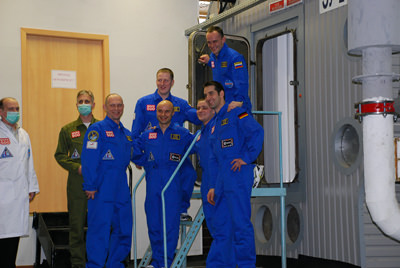[/caption]
Earlier today in Moscow, six people were locked inside a hermetically sealed living space, where they will remain for the next 105 days. They will eat dehydrated food, have limited contact with the outside world and will be constantly monitored. No, it’s not another season of ‘Big Brother’, but a joint experiment by the European Space Agency and the Institute for Biomedical Problems (IBMP) of the Russian Academy of Sciences to study the effects a mission to Mars would have on a human crew.
The crew consists of six volunteers, two selected by the ESA and four by the Russian Academy of Sciences. Oliver Knickel, a 34-year old German engineer, and Cyrille Fournier, a 40-year old French airline pilot will represent the ESA. The four Russian crew members are Oleg Artemyez, a 37-year old cosmonaut, Sergei Ryazansky a 34-year old cosmonaut and biologist, Alexei Baranov a 34-year old doctor, and Alexei Shpakov, 25, who is a sports physiologist.
These six, along with two alternate candidates willing to step in at the last minute, were chosen from over 5600 applicants for the first stage in the Mars 500 isolation study. The crew will live in a small, cramped module designed to simulate a potential craft that would send astronauts to Mars. The Mars mission mock-up is located inside a research facility at the Institute of Biomedical Problems in Moscow.
The 105-day study will simulate all aspects of a mission to Mars. The crew will have no communication with the outside world besides delayed radio communication with mission control, and radio contact with friends and family, much like that of astronauts aboard the International Space Station. Simulated emergencies such as equipment failure will test the ability of the crew to overcome difficulties that may endanger an actual mission, and there is the danger of real emergencies from disease or injury inside their sealed facility.
The crew will be far from bored during the simulation, as they will perform scientific, maintenance and quotidian duties much as they would on a real mission. A greenhouse will also need tending to provide the crew with fresh vegetables, and there will be a gym available to the participants to help keep them fit. Instructions from the mission directors and reports from the crew will be on a 20-minute delay, as would be the case on a real Mars mission.
The habitable area of the isolation facility has 6 individual rooms for the participants, a kitchen/dining room, living room, main control room and toilet. In addition to the habitable module, there is also a Mars lander module, which the crew during the longer 500-day mission scheduled for later this year will use to simulate a landing on Mars. A medical module and utility module will house other equipment necessary for such a long-term mission.

A potential manned mission to Mars would pose many challenges to the astronauts involved, and the Mars 500 series of isolation studies hopes to try and work out any ‘kinks’ while humans are still safely on the planet.
“It is of paramount importance to understand the psychological and physiological effects of long-duration confinement, to be able to prepare the crews in the best way possible and to learn about important aspects of the vehicle design. To contribute to their psychological well-being and long-term performance, we need to learn how to support the crew with optimum nutrition, artificial light, appropriate medical countermeasures and also planned and off-nominal task management.” – Martin Zell, Head of the ISS Utilisation Department in ESA’s Directorate of Human Spaceflight
ESA crewmembers Cyrille Fournier and Oliver Knickel will keep a diary of their experience, which will be available on the European Space Agency site here.
Fournier wrote in anticipation of the program, “During the study I look forward to observing how communications develop and how relationships are established between crew members. I expect that each of us will feel both highs and lows, mentally, physically and socially. I am however optimistic about how the experiment will turn out as I strongly believe the group, as a whole, will be able to overcome momentary and personal downs.”
As always, we’ll keep you posted here on Universe Today as to how the simulation goes.
Source: ESA


kool!
No women? How realistic is this going to be?
Citizenship is not well balanced. 4 Russians versus 2 Foreigns would be a problem? All Russians or all 6 members of different citizenship.
@huygens
Have you ever been to San Fransisco-very realistic there>
I agree- I would have to take a pass on that one- 3 men and 3 women- or even better-One man and 5 women- the odds would be on my side.
What if they kill each other?
On a more serious note, you cannot simulate the intangible aspects of such mission, which are clearly the most important when it comes to physical and mental health. The truly mind-screwing thing about being at Mars would most likely be the sledge-hammer realisation that you cannot stop the Mars trip and get off – you are 100 million or more kilometres from Earth, and there isn’t a damn thing you can do about it. Don’t like Mars or your crew members? Too bad. Family member gets cancer? Too bad. Wife or husband leaves you for somebody else? Ha! You’re screwed. Sudden onset of serous homesickness etc. etc. etc. If you read the famous book Red Mars, these issues are covered extremely well. They are obvious, but the true terrifying reality of them cannot be simulated – the people in this experiment, deep-down, know that they are at home, and that if they were in real danger or distress, NASA would be obligated to get them out.
citzen issues will always be apart of the human race and gender equality certainly those have got it all too wrong.but that isn’t too bad as compared to what the americans are doing to the russains on board the iss you know what ?the uncle sam guys are stoping the russians from using the toilet how bad is that ?
Hmm . . . will this test crew be equiped to repair the ‘urine processor’ themselves if it fails? Or will the crew be furnished a 105 day supply of water and no urine processor?
Men.
Men…No women.
Who says a real Mars crew wouldn’t be monogender? It’s easier that way.
Hey, nice tips. I’ll buy a glass of beer to that person from that forum who told me to visit your blog 🙂